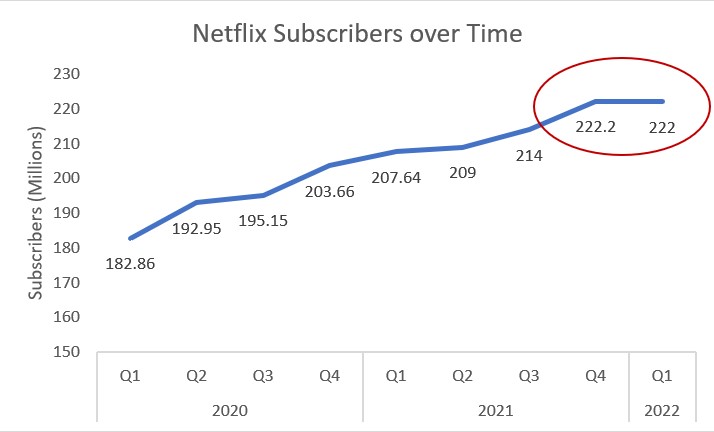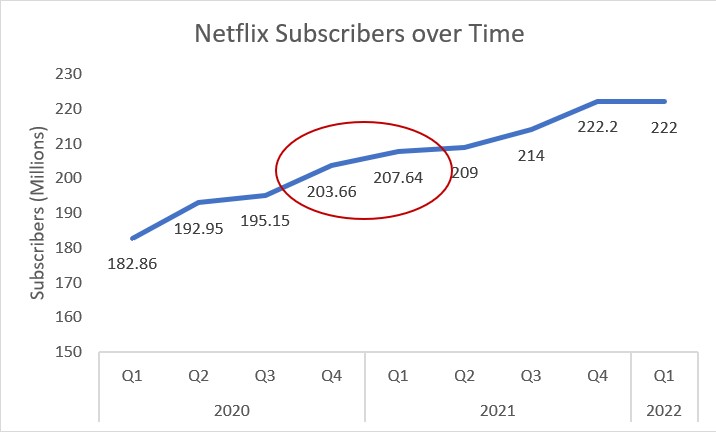Netflix, the most popular streaming service in the world, lost subscribers for the first time in ten years last quarter. The sudden downtick came as a shock to Netflix and the media world, which had predicted that the service would double its subscriber count in the next few years.

What happened? Is Netflix in trouble?
The Flawed Goal of Streaming Services
Many have attributed the drop to competition from other streaming services, password sharing among Netflix users, and the global economy moving on from the pandemic. The trouble with these explanations is that they’ve been known for at least the past year. Everyone still thought the subscriber count would go up.
The problem could be more deeply rooted than people think.
Imagine you work at a streaming service and you were trying to decide whether to buy a certain TV show from another service. How would you decide if the show were a good purchase?
I’ve spoken to people that have worked at streaming services. The metric they used to value content is how many hours viewers spent watching the show. At first glance, that makes sense, right? The more you watch a show, the more the streaming services think you value their content, and therefore, the more likely you are to stay subscribed to their service.


The problem is that thinking might be, well…wrong.
Why More Hours Watched Doesn’t Equal More Subscribers
When streaming services attempt to provide content that makes viewers watch the most hours, they might actually be reducing the number of people that stay subscribed to the service.
To understand how this can happen, think about how you actually use streaming services. If you’re like most people, you probably subscribe to a service, say Netflix, to watch two or three TV shows you’re really interested in and a couple movies you always wanted to see but missed in the theaters.
The rest of the time you might play a TV comedy in the background while you work, browse the web, or cook dinner.
That is, there are two types of viewing behavior. One is intentional viewing – you opened up Netflix specifically to watch that piece of content. The other is ambient viewing – you weren’t planning to watch a specific piece of content as much as you needed to have something ‘on’ while doing something else.
The problem with ambient viewing is that it generates a lot of hours but not a lot of brand loyalty which, in turn, keeps viewers subscribed.
Consider The Office, a typical example of ambient content. The show was Netflix’s most viewed piece of content throughout the 2010s. When it left the service at the end of 2020 for Peacock…nothing happened. There was no mass exodus of subscribers from Netflix to Peacock. Netflix subscribers looking for background noise simply replaced The Office with something else.


Netflix Has Been Putting Out Weaker Content Over Time
The “more hours, more subscribers” metric of performance doesn’t really distinguish between intentional viewing and ambient viewing, and it drives streaming services to provide, well, crappy ambient content.
In Netflix’s case, the company has shifted focus away from high-quality movies (which generate only a couple hours per view) to generally lower-quality TV shows. Even Netflix’s TV shows themselves seem to have gotten worse. An analysis by What’s on Netflix found that the average IMDB rating for Netflix’s original films and original television has declined over time. The company has also begun investing more heavily in reality shows, which could drive down overall perceptions of quality even further.
Part of this shift, of course, has to do with the rise of competitors. Disney and HBO Max in particular have removed their top film libraries from Netflix. To their credit, Netflix executives correctly predicted that viewing hours wouldn’t be harmed by rival services. They just didn’t realize how a shift in quality would impact their subscriber retention and growth.
Despite following the same “more hours, more subscribers” model, the other streaming services, like Disney and HBO Max, might be unintentionally benefiting from providing high-quality content, like Pixar movies or Lord of the Rings, respectively, that keep viewers subscribed.
A Path Forward
In my view, Netflix has two options going forward.
The first is to continue focusing on viewing hours, but find better ways to profit from them. That involves placing ads on the platform, much like other TV or ambient-focused platforms, such as your typical cable networks, Hulu, and YouTube.
The other is to improve the quality of its programming to regenerate the excitement that made the company a success in the first place. This strategy would call for producing fewer, larger budget television shows and more movies.
Given the dominance of rival studios in producing high-budget blockbuster films, however, I think Netflix will stay the course and introduce ad offerings to keep making money.
Only time will tell if that strategy will pay off in the long run.



